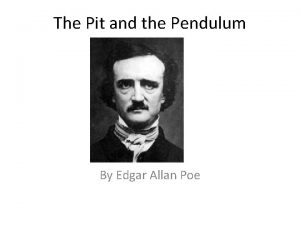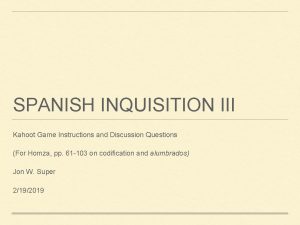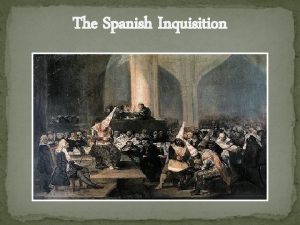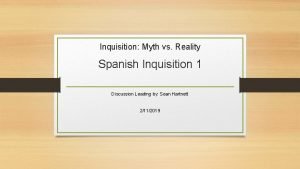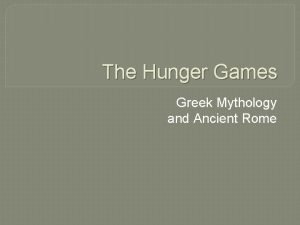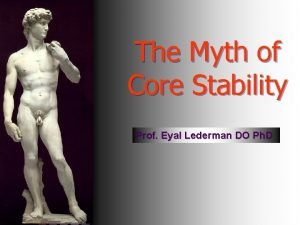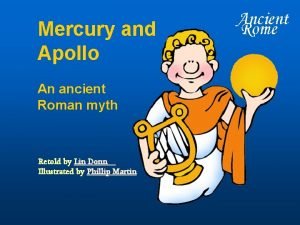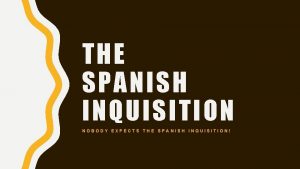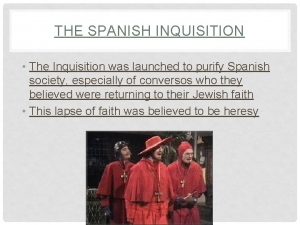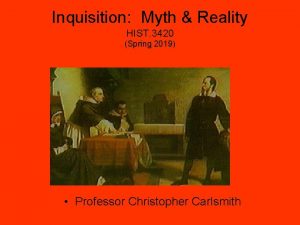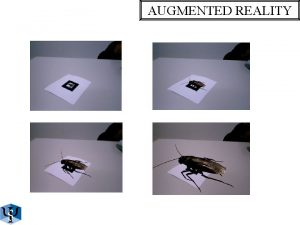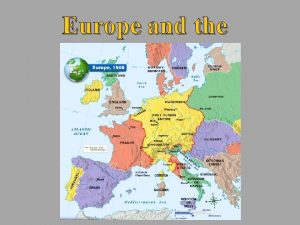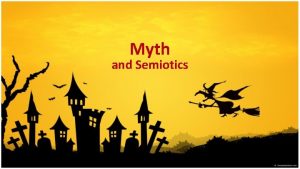Inquisition Myth vs Reality Spanish Inquisition 1 Discussion











- Slides: 11

Inquisition: Myth vs. Reality Spanish Inquisition 1 Discussion Leading by: Sean Hartnett 2/11/2019

Announcements • Book Review selection needed from: • • Alec, Christian B, Matt, Megan, Nick, Alex, Chrisian M, Hary, Cam, Colin, John, Ty Primary Source Summary due Wed, 2/13: • • • Select any primary source (e. g. , Homza, Fournier, Gui, other) Write a one-page summary Include the 5 Ws (who, when, where, what type of source, why created), as well as a brief description of the major idea(s) in the source

Discussion Questions: • In comparison with the Medieval Inquisition, what are new • • developments in the Spanish inquisition? Which procedure(s) of the Span. Inquisition led to its terrible reputation? Did the Inquisition have popular support (according to Kamen)? Identify one fact that surprised you about trial procedure in the Spanish Inquisition. What might we learn (if anything) from the statistics on pp. 18384 and/or from the images on 192 -93?

Myth vs. Reality Exercise Split into 4 groups. Review the provided index cards. Determine the truth or falsehood of each statement on the card. Each group has a different set of cards, based upon the various stages of inquisitorial procedure (based upon Henry Kamen’s 2 chapters). Arrange the index cards into two groups: Myth, Reality.

A Heretic’s Journey: From Accusation to Punishment • • Combine your group with another group. Organize the ten steps of a heretic’s journey by arranging the paper strips in the correct order. Verify your order with the discussion leaders. Each person in the group should add detail to one of the steps (additional information, example, analysis, etc. )

Spanish Inquisition: Structure, Personnel

Structure of the Spanish Inquisition Spanish Monarchs Pope - Council of Finance Inquisitor General (1+) - Council of State - Council of Indies Suprema (6 -8) Local Tribunals Portugal Post-1586 Castile Aragon Cf. Kamen, p. 145 map Local Inquisitors -assessor (calificador) -constable (alguacil) - Prosecutor (f. Iscal) Familiares (lay servants) GENERAL PUBLIC Dependencies New World Sicily Sardinia Majorca Canary Is. Mex. City Lima Venez. Comisarios (parish priests) GENERAL PUBLIC

The Spanish Inquisition: Procedures (adapted from Kamen) • • • 1. Edict of Grace (2 weeks to several months) Edict of Faith (post-1500) 2. Evidence assessed by calificadores (theologians) 3. Fiscal (prosecutor) draws up arrest warrant 4. Arrest of suspect(s), followed by inventory and confiscation of property 5. Three warnings to urge the accused to confess (over several weeks) 6. The suspect answers to the charges immediately after being informed. 7. The accused is permitted legal counsel and presentation of evidence 8. “trial” with a series of audiences, and a consulta-da-fe 9. Auto-da-fe (exhibition of faith) 10. Punishments, including: • wearing of a sanbenito, pilgrimage, penitential participation in liturgical ceremony, confiscation of goods, scourging (ca. 100 lashes), imprisonment, exile, service on galleys, or the stake for unrepentant or repeat heretics.


Discussion Questions: • In comparison with the Medieval Inquisition, what are new • • developments in the Spanish inquisition? Which procedure(s) of the Span. Inquisition led to its terrible reputation? Did the Inquisition have popular support (according to Kamen)? Identify one fact that surprised you about trial procedure in the Spanish Inquisition. What might we learn (if anything) from the statistics on pp. 18384 and/or from the images on 192 -93?

 What is the setting of the pit and the pendulum
What is the setting of the pit and the pendulum Kahoot instructions
Kahoot instructions Zoos connect us to the natural world claim
Zoos connect us to the natural world claim Zoos myth and reality answers
Zoos myth and reality answers What was the inquisition
What was the inquisition The inquisition definition
The inquisition definition Simple distillation discussion
Simple distillation discussion Reality spanish
Reality spanish Spanish 1 semester 1 final exam answer key
Spanish 1 semester 1 final exam answer key What greek myth is the hunger games based on
What greek myth is the hunger games based on Tim lederman
Tim lederman Mercury and apollo
Mercury and apollo
